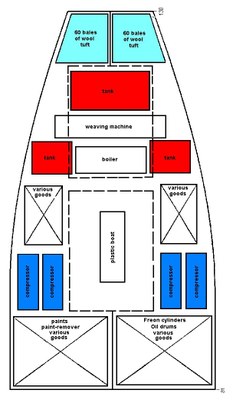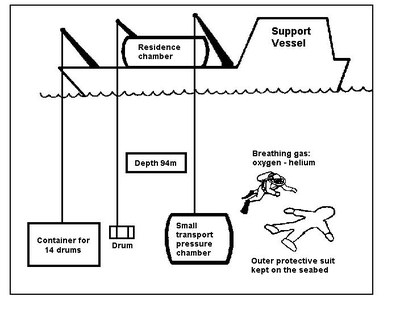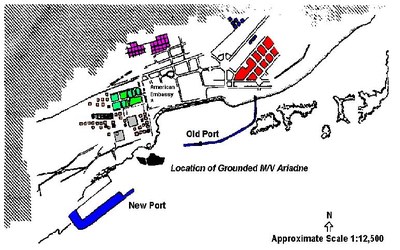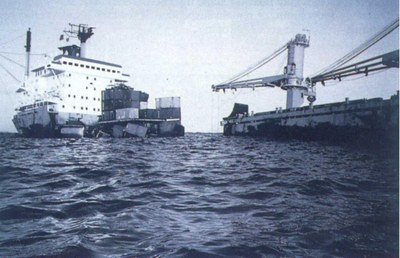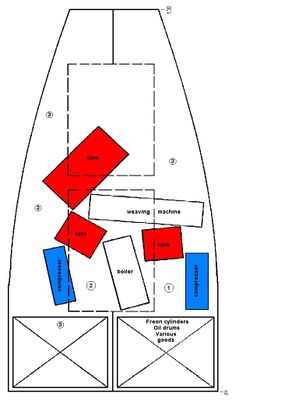1974 - Cavtat
| Year | 1974 |
| Vessel | Cavtat |
| Location | Strait of Otranto, Italy |
| Cargo type | Package |
| Chemicals | TETRAETHYL LEAD |
Summary
On July 14, 1974, the general cargo vessel Cavtat (2,092 grt) was sailing from Manchester, U.K. to Rijeka, Croatia, when she collided with the bulk carrier Lady Rita (11,213 grt) in the Strait of Otranto, off the S.E. coast of Italy. The crew of the Cavtat was picked up by the Lady Rita and taken to the port Taranto, Italy, but the Cavtat sank about 3 nautical miles off the coast in about 94 metres, four hours after the collision.
The Cavtat was carrying a variety of cargo among which was 2,800 tons of chemicals, including 389 tons of alkyl lead in 900 drums of which 404 drums of tetraethyl lead were stowed under deck and 496 drums of tetramethyl lead stowed on deck.
Narrative
On July 14, 1974, the general cargo vessel Cavtat (2,092 grt) was sailing from Manchester, U.K. to Rijeka, Croatia, when she collided with the bulk carrier Lady Rita (11,213 grt) in the Strait of Otranto, off the S.E. coast of Italy. The crew of the Cavtat was picked up by the Lady Rita and taken to the port Taranto, Italy, but the Cavtat sank about 3 nautical miles off the coast in about 94 metres, four hours after the collision.
The Cavtat was carrying a variety of cargo among which was 2,800 tons of chemicals, including 389 tons of alkyl lead in 900 drums of which 404 drums of tetraethyl lead were stowed under deck and 496 drums of tetramethyl lead stowed on deck.
Resume
The first response action was an exclusion zone of two miles radius for fishing from the point of sinking. Subsequently the wreck was located in 94 metres water depth by echo-location using a Navy vessel. The wreck was inclined 5o to its port side.
On October 23, 1974, the owner of the Cavtat was ordered to remove the vessel and/or the cargo due to the potential danger the cargo posed to the marine environment. Meetings were held between the authorities and representatives of the ship to discuss the implications regarding the recovery of the vessel and of the cargo which could be a potential threat to human health and to the environment. Scientific investigations in the immediate vicinity of the wreck did not show pollution from the alkyl lead compounds.
On July 21, 1975, the ship owner presented a project for the recovery of the cargo lying on deck. This recommended a preliminary inspection of the wreck and of the surrounding area as a start. Since the ship owner had not fulfilled the terms of the order for the removal of the ship and/or all the cargo, the authorities decided to take the situation in hand to recover the cargo.
On April 6, 1977, the Italian Parliament approved the financing of the operations for the recovery of all hazardous cargo.
A contract was drawn up with an Italian offshore company, Saipem, for the removal of the drums containing alkyl lead whilst the manufacturers of the product, Octel, requested that the drums recovered be returned.
An initial survey carried out by Saipem showed that the 900 drums were distributed as follows: 496 drums containing tetramethyl lead product on deck; 404 drums containing tetraethyl lead distributed accordingly; hold No. 1, 350 drums and hold No. 2, 54 drums.
The operation was planned as follows:
1) taking samples from the sea bottom and water in the area of the wreck;
2) recovery of the drums on deck found in the mid-deck area as well as those on deck found over hold No. 2;
3) removal of any obstruction including accident debris which could have accumulated between the poop and the central deckhouse;
4) recovery of the drums in the area of the deck over hold No. 1;
5) recovery of the drums lying on the bottom;
6) recovery of the drums lying in the holds;
7) transfer of the drums to shore.
For the operations, the following means were used:
1) a vessel which could support saturation diving and equipped for hydraulic work at a depth of 150m including photographic and video systems;
2) a vessel used for transfer of personnel;
3) a vessel used for the transfer of the drums.
In April 1977, the operation for the salvage of the drums began. Saturation diving using a mixture of oxygen and helium was utilized. For safety reasons, work was only carried out under favourable meteo-oceanic conditions and in daylight. Divers worked in pairs for 8 hours/day for 20 days. When not working, they stayed the rest of the time in a pressure chamber on the deck of one of the vessels. After 20 days under pressure, the divers were subjected to a 3-day decompression period after which a new team of two divers took over. During the work phase, the pressure chamber would be lowered to a place close to the wreck, the divers would exit and don outer protecting suits left on the seabed (Figure 1). Radio communications took place between the divers and the salvage vessel during the salvage operation.
The procedure for raising the drums either involved lifting the drums one at a time and using overpacks as necessary or moving the drums to a special container which was able to hold up to 14 drums. When the container was full, it was rendered watertight and lifted onto the vessel and placed into a reception tank. After the container with the drums was opened, water which spilled into the reception tank from the container was tested for contamination. Furthermore, each drum was surveyed individually by placing it in an oversized tank, opened to release any overpressure, a sample taken and contents transferred to another drum. Each recovered drum was registered and the area from where the drums taken mapped accordingly. In cases where a drum was found to be leaking, after transfer of its contents, it was also placed in an overpack.
Operations started with the recovery of the drums on deck which ended in July 1977. 493 drums were recovered, the last 3 being recovered in December 1977.
In July 1977, hold No. 1 was opened. According the loading plan, cargo should have been stowed as shown in Figure 2 but the situation found was in fact that shown in Figure 3. This cargo had to be removed to get at the other drums.
Work for the recovery of drums in holds No. 1 and No. 2 recommenced after the winter period in March 1978 and was completed in April. At the end of the operation, 873 drums were recovered, 32 of which were found empty whilst 27 drums were not recovered.


